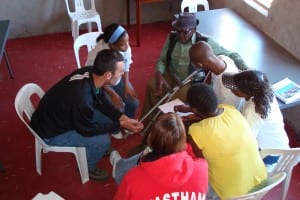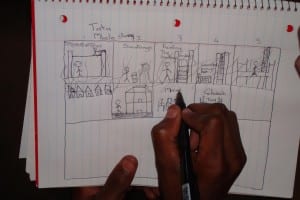Photography as a Community Initiative
 Photography as a Community Initiative
Photography as a Community Initiative
In the first week, we started an informal photography and video training session with the co-researchers. We worked with a video camera that had been left in the Indlovu Center by the 2008 Communications team. This training entailed working with the video camera, identifying the main operational features such as turning it on/off, recording video clips as well is zooming in and out. This training lasted about three days. We later went on to work with digital cameras, computers, and story boards. We focused on using the story boards as a way to approach the different issues the co-researchers wanted to explore. We started with topics that would interest the co-researchers and that they would have fun working on. As a group they interviewed Tata Mbele about his contributions to the Indlovu project. Individually they wrote stories about their own lives, made a story board, and then used a digital camera to document it.
 During the tours where the co-researchers took the various WPI project teams out into the community, we had the co-researchers take any pictures that the team needed for their project. This allowed the co-researchers to get more practice with handling a camera as well as allowing the community to feel more comfortable because it is less intrusive. This became a good way for the community to start becoming aware of our work since when witnessing the co-researhcers taking pictures they could ask what they were doing. The co-researchers would give them a brief overview of the work that WPI and the Indlovu Project were doing in Monwabisi Park. The co-researchers really enjoyed using the camears and began to show more of an interest in photography as opposed to video.
During the tours where the co-researchers took the various WPI project teams out into the community, we had the co-researchers take any pictures that the team needed for their project. This allowed the co-researchers to get more practice with handling a camera as well as allowing the community to feel more comfortable because it is less intrusive. This became a good way for the community to start becoming aware of our work since when witnessing the co-researhcers taking pictures they could ask what they were doing. The co-researchers would give them a brief overview of the work that WPI and the Indlovu Project were doing in Monwabisi Park. The co-researchers really enjoyed using the camears and began to show more of an interest in photography as opposed to video.
With much discussion within our team, we decided to pursue the participatory photography as we thought that taking still pictures would be easier to work with than video recordings which would have required some editing. We began incorporating a voice recorder and recorded the co-researchers talking about their life stories. We had not totally abandoned working with video as we later worked on Siya’s story board using all three components: participatory photography, voice recording and participatory video. The still pictures were complemented well by the voice over. When we added the video, we realized that the sound quality was bad and so using just the pictures and the voice recordings was a good methodology to adopt.
Photo boards
After we completed the training and experimenation with photography we needed a way to apply it to the community’s involvement in the redevelopment process. We wanted to use photography to inspire the community and allow them to feel included in the Indlovu Project. We used photo collage boards as a way of unifying the community and raising awareness about the work the Indlovu Center does. The photo boards were constructed with the help of Robert Taylor, the project manager of Ecobeam Technologies. He constructed three boards for us that were used as display areas for the photo boards. On celebration day the co-researchers took pictures of community members and made a collage of all the pictures to be displayed in the community center. Besides this community photo board we also prompted the co-researchers to create photo boards for business advertising and portraying the hard work at the Indlovu Project. The plan is for these photo boards to continue to grow and remain in the community centre to explain the work of the Indlovu Centre.
Picture Taking of Businesses in Monwabisi Park
The co-researchers went around the park and notified the different businesses around Monwabisi Park of an opportunity for their businesses to be advertised at the community centre. If the business owners were ready, the picture was taken right then but if the business owner preferred for the co-researchers to come back at another time, an appointment was made and the co-researchers returned on a later date. The picture had a brief description of where the business is located, name, services it renders to the community, operating hours, the owners and contact information. For the business collage, 8×11 pictures were printed from the photo printer onto photo paper and then stuck up on the photo board for advertising, along with captions and details about where the business is located, what service is being rendered, name of the company, the owners contact details and operating hours. These pictures were displayed in a collage format in the community centre where additional pictures could be added should another business open. The team hoped this would bring the community together as the community would find out about a particular business at the community centre, and in turn support the business by purchasing something or using the businesses services that they have had offer. We also hoped that the business owners will in turn feel like valued members of the community and so gain interest in the redevelopment efforts in Monwabisi Park.
Picture Taking of Families in Monwabisi Park
The co-researchers took pictures of families around Monwabisi Park. Considerations were made for the time these pictures were taken. Times when all the family members were together was the best time to take these pictures. So these pictures would be taken either during the weekends or in the evenings when the complete families were guaranteed to be home if they had any working members of the family. The co-researchers had to make themselves available at those times.
Approaching families and asking them if they would like a family portrait was the best way of advertising the photo shop and making the services of the photo shop known to the community. The team thought family portraits were a good idea as we saw it as a way to make the community members feel valued and give something tangible back to them, something that will always remind them of the work the Indlovu center does.
Picture Taking of Tourists Who Visit the Indlovu Project
Taking photographs in the community can be seen as intrusive if conducted by outside parties so the co-researchers, as a service of the photo shop, are available to take volunteers or guests around the community and take pictures for them. After the pictures are taken the volunteer or guest paid for the pictures to be printed and/or put on a CD to take home. This picture taking service is also offered as a package that complemented the tours that already take place around Monwabisi Park. As way of showcasing the involvement of the guests and volunteers in the Indlovu project, their pictures will be posted on the volunteer photo board in the community centre if they desire. This photo service was used on the celebration day to provide documentation of the event and allow any outside visitors to experience the park and to have their picture taken.
Photo Shop Service
From the success of the community photo boards and the interest of the community and the co-researchers we realized there was an opportunity to expand the program. Since we wanted to ensure that the collages and other photo aspects remained sustainable we invested in a digital camera, photo printer, paper, and ink to remain at the Indlovu Center. To optimize these supplies we began to set up structures to create a photo shop. This photo shop would bring in revenue to the Indlovu Project while advancing the photography initiative.
We developed a manual for operating the camera and printer which also included a price list for the services the photo shop provided in case there were any difficulties now that we have left.


